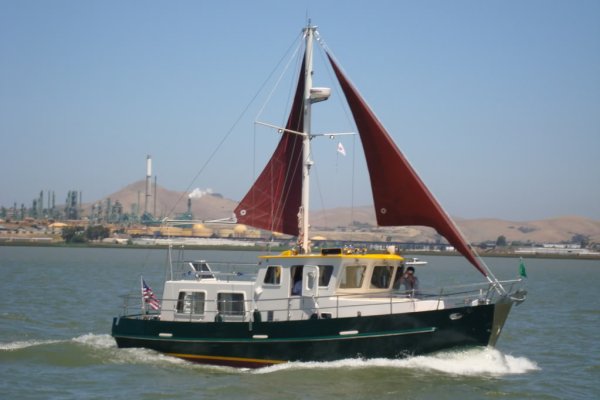How big of a Diesel outboard are you thinking?
I've personally never seen one so I just googled. The only ones that come up on a quick search are as others have pointed out...rather large
there's a 175 HP Mercury. Something like that?
I wonder, if you're talking about a tiny little engine running at a good clip just to barely crawl the boat along it seems like that wouldn't be very fuel efficient...and therefore the mission is defeated right away.
If it's a larger one...such as the 175 HP I found....running at a slow efficient speed to barely move the boat, how efficient would that be?
This thread is making me wonder if our 4hp Yamaha dinghy motor can move the mother ship at all if I mounted it to the swim step somehow. Moves the 65 lb dinghy pretty well. Not sure about 27,000 lbs. I suppose I could try to tow the mothership with the dinghy first, that might be hilarious. Better choose a glass-smooth day next spring. I have this vision of a mouse in a harness trying to budge a locomotive.
Oh, the variety. 4 hp and 175 hp. Obviously it depends on the boat, but if we're talking a boat being used offshore and needing a get home motor, then 4 hp isn't going to be adequate. When I mentioned the Mercury 175 earlier, I consider that to be an appropriate size for this purpose. I'm betting the boat's primary engine is that size or greater and it's better mounted and designed for the boat. I've seen very large boats moved by outboards on the swim platform and it's been sizable outboards. To serve the purpose, it must move the boat through winds, waves, and currents which may be working against it. Does it need to be 175 hp? Perhaps not, but at least 50-75-100 range and 175 isn't completely out of line. We have pulled our boats as experiments using our RIB's to tow them, much like pilot boats do. It's one thing to do in calm inland or even coastal waters, but the task of doing it with wind and waves beating into the boat being towed is an entirely different world.
Now, I would not recommend using any type engine in this matter. I agree with others on maintenance and spares. Then if you feel the urgent need of some sort of emergency get-home method, go with proven solutions of twin engines or regularly installed get-home engines. If one's generator is large enough, then running propulsion off it is a reasonable solution. I'd just go to professionals who have done it. Also keep in mind that while fuel is one of the most common culprits, it's the easiest to address. Meanwhile, props and shaft and entire propulsion systems require another if damage badly enough. Loss of steering or gears requires a redundant system.
Ultimately, I'd suggest protecting oneself the most one reasonably can. That considers the likelihood of risk and the affordability of the protection against it. That will leave risk you aren't fully protected against. You can evaluate what you'd do in those situations. At some point a Coast Guard from the nearest country and abandoning the boat until you could get back to it somehow with another boat or abandoning it permanently may be the answer. Insurance will perhaps engage a salvage company at that point but all you can save is your lives. Hopefully, no one here will ever have to make that decision, but if one faces it, I'd say strongly, don't refuse to make it and don't wait too long. Coast Guards don't mind at all getting called and then just as they arrive you're able to get going again. They do mind people dying that they could have saved if only they'd been called more quickly.
I'm as risk adverse as anyone you'd ever meet, but I do realize I can't eliminate all risks. When I drove home from the office today, I had no control over what all the other drivers would do. In fact, I took other risks. I wasn't driving a Volvo Sedan or a large safe SUV. I was driving a sports car with the top down and enjoying such a beautiful sunshiny Fort Lauderdale afternoon. It made me feel good. Short drive, but something about sunshine and palm trees as the sun is just starting to set. I travel the route we took often, but Las Olas will never lose it's charm, nor will seeing boats lining the canals. In fact, got home, had a nice dinner and plan on swimming later. Just not sure how we're going to juggle baseball, basketball (sorry skipping football tonight), and the 500th edition of Law and Order SUV (thinking it has to wait until later tonight and DVR).
When we travel long distances offshore, I know I'm not 100% safe. No delusion. But I feel 99.9999% safe and much safer than many other things I do. I've never done truly dangerous things like mountain climbing or things others here might have done, but imagine the feel as the most dangerous things I have done have been to help others and they're the moments in life I treasure most.



